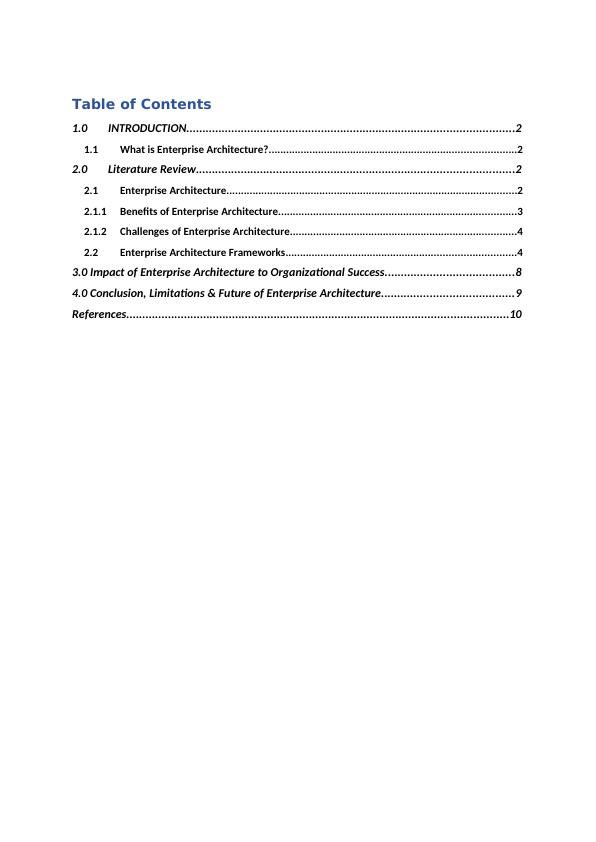An Introduction to Enterprise Architecture
Added on 2021-06-05
12 Pages3571 Words124 Views
21453405Ishola, Iyanu-Oluwa Emmanuel.ELEMENT 3: INDIVIDUAL ESSAY.

Table of Contents1.0INTRODUCTION......................................................................................................21.1What is Enterprise Architecture?.....................................................................................22.0Literature Review...................................................................................................22.1Enterprise Architecture....................................................................................................22.1.1Benefits of Enterprise Architecture..................................................................................32.1.2Challenges of Enterprise Architecture..............................................................................42.2Enterprise Architecture Frameworks...............................................................................43.0 Impact of Enterprise Architecture to Organizational Success........................................84.0 Conclusion, Limitations & Future of Enterprise Architecture.........................................9References.......................................................................................................................10

1.1INTRODUCTION.1.2What is Enterprise Architecture?Enterprise Architecture the process through which evaluating, development,organising and applying organizational analysis to effectively execute marketstrategies. Enterprise Architecture helps enterprises organise InformationTechnology programmes as well as strategies to produce the optimal businessoutcomes and to keep up with market changes and disruptions by utilizing designprinciples and practises, a method also known as enterprise architecturalplanning[ CITATION Sar18 \l 2057 ]. As a result, Enterprise Architecture provides ablueprint for proper Information Technology technique and guides the controlledevolution of Information Technology in a way that delivers cost-effective businessbenefits. Enterprise Architecture helps companies to build strategic advantages,minimize risk and foster cost-effectiveness and interoperability[ CITATION Kei20 \l2057 ]. One of the building blocks of enterprise architecture has beendigitalisation (changing of pictures, sounds as well as texts into digital format). Itcan be difficult to direct and coordinate intelligently the vast volumes ofinformation being processed. In a broad corporation, performance (and creativity)is frequently sacrificed as a result of red tape[ CITATION Jaa04 \l 2057 ].Enterprise Architecture offers a route for these companies to transition from thecurrent to a more desirable future. Enterprise Architecture helps organisations tobe able to:Provide a wide picture, a long-term view.Establish administrative processes and procedures with a focus on businessstrategies.Establish a set of measures and procedures for personnel to support dataorganisation.Ensure consistency and integration. Develop a strategy of measures aimed at meeting the company's goals.2.0Literature Review2.1Enterprise ArchitectureEnterprise architecture is a theory which has been in existence for nearly twentyyears. Meanwhile, fields such as Enterprise System Integration, BusinessIntelligence Reengineering and Maximum Quality Control, shed light on therelationship between process-oriented management and support for businessprocesses by information technology.[ CITATION Soury \l 2057 ] However, severalof the techniques that originated out of these foundational studies do not includeholistic models of the components of the organisation as laid out in the Orthodoxenterprise architecture. Many references to business architecture found inpopular literature express this holistic vision:

Enterprise Architecture consists of identifying, as well as, recognising thevarious components that make up the organisation and how those elementsare interrelated.[ CITATION Ope03 \l 2057 ].Enterprise Architecture is a methodology that handles competingapproaches to performance in large-scale organisations. A specialisationcommitted similarly to the realms of IT and industry, it implements functionalcriteria across departmental divisions and teams in order to streamline effortsthrough intelligent resource sharing. [ CITATION Lea21 \l 2057 ].2.1.1Benefits of Enterprise Architecture Enterprise Architecture is driven by the market needs of the organization—ithelps to set out how information, business and technology work together. Thishas become a priority for companies that are striving to keep up with newtechnology such as cloud, IoT, artificial learning and other technologicaldevelopments that can contribute to digital transformation. The systemeffectively integrates individuals, data and technologies to demonstrate athorough understanding of inter-relationships within the IT enterprise accordingto [ CITATION Sar18 \l 2057 ]. The method is driven by a "comprehensive pictureof the entire enterprise from the perspective of owner, designer and builder."Unlike other structures, it does not provide a structured reporting structure;instead, it is designed to include a more immersive vision of the enterprise. Agreat Enterprise Architecture approach recognises the latest developments incompany methods, corporate structure, information management andtechnology. It will also provide common terminology and best practises forbusiness procedures, and an overview of where processes should be integratedor removed in the enterprise. Enterprise Architecture can provide support for re-design and re-organization, particularly during significant organisationalchanges, mergers or acquisitions. It is also helpful to add more discipline to theorganisation by standardising and consolidating procedures with betterconsistency. Enterprise Architecture is also used in system development, ITadministration and decision-making, and IT risk management to fix bugs, systemvulnerabilities and security breaches. It can also help companies managedynamic IT systems or make IT more available to other business units. Accordingto [ CITATION Com17 \l 2057 ] the following are the benefits of EnterpriseArchitecture:Enabling further flexible cooperation between IT and market segments. Giving companies the freedom to prioritise development. Providing an opportunity to test current architecture against long-termobjectives. Setting up systems for evaluation and procurement of technologies. Provide a holistic view of IT structure to all divisions outside of IT. Provide a benchmarking system to efficient production with othercompanies or guidelines.2.1.2Challenges of Enterprise ArchitectureA research which was performed by[ CITATION Dag17 \l 2057 ] and [ CITATIONAje18 \l 2057 ], in Norway. The two research were carried out through

End of preview
Want to access all the pages? Upload your documents or become a member.
Related Documents
Enterprise Information Architecture Reference Architecture for Electronic Health Record Developmentlg...
|20
|3512
|186
Business Process Engineering and Intelligent BPM in the Era of Big Datalg...
|9
|2391
|332
INF 80018 Enterprise Architecture, Strategy and Governance Assignmentlg...
|18
|4051
|130
Application of Enterprise Information Architecture in e-Governmentlg...
|12
|2204
|78
Enterprise Architecture and Governance Assignment 7lg...
|7
|1914
|396
IS Strategy, Architecture, and Business Alignmentlg...
|11
|2996
|474